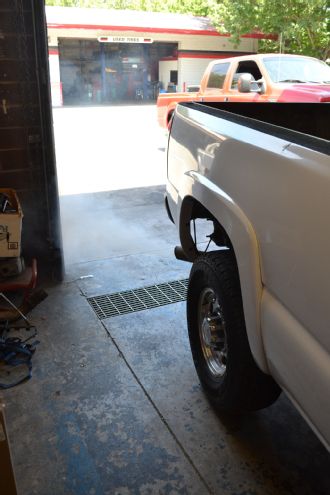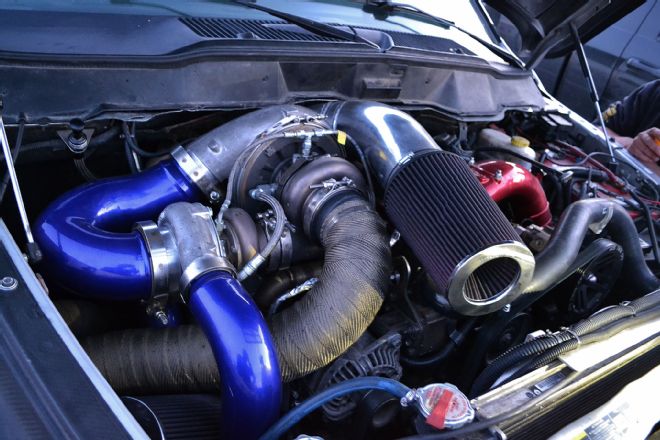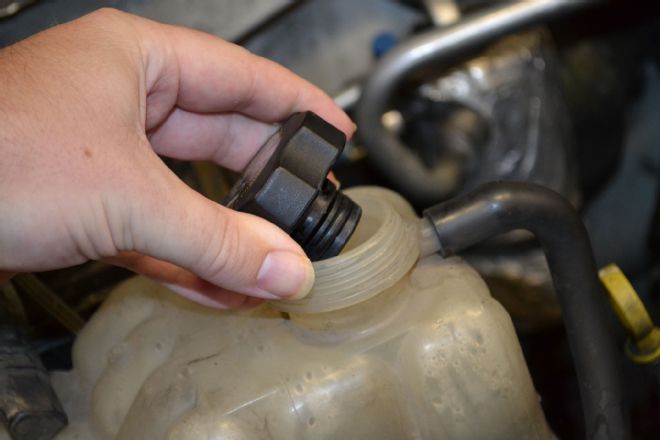Diesel Tech Questions: White Smoke
White Smoke Part One
I have an '06 Dodge Ram with a 5.9L Cummins engine, and I am having some problems. Sometimes when it is cold, the truck sputters and blows white smoke, and it takes a few minutes to clear out. I just had the injectors rebuilt, so I hope that's not the problem. The truck has 60-hp injectors, a 63mm turbo, water-methanol, and a host of other modifications. Any chance you can help with this?
Ronnie Sloss
-Via email

| No matter what the year, make, or model of a diesel, large amounts of white smoke out the tailpipe are not normal, and should be researched to see if there is a problem.
White smoke can mean a few different things, but it shouldn't be that hard to narrow down. If it is smoking out the tailpipe, that means that either coolant or a bunch of excess fuel is getting into the combustion chamber, or the engine is low on compression. An easy test to see if the engine has an excess amount of blow-by is to pull the breather cap on the valve cover and check for smoke. If there's a bunch of white smoke coming out from the valve cover, then you might be a cylinder down.
Another possible issue is a worn-out injector, an injector with a cracked tip, or a bad harness or solenoid. If this is the case and too much fuel is being injected, a shop can cap off the feed line to each injector, one at a time, until the culprit cylinder is found. Even if the injectors are "rebuilt," many companies just put new parts inside of older core injectors, and then send them out without testing them. For injector rebuilds, it’s best to go with a shop that will provide an actual flow sheet when shipping out a set of new injectors.
Finally, check your coolant level, and see if it's dropping. If there's enough coolant loss that the engine is sputtering in the morning, then that means you have a serious problem. While coolant loss into the engine is a common issue on Fords, it's much rarer to find a Chevrolet or Dodge with the same issue. If it is losing coolant, whatever you do, don't just keep adding coolant and driving the truck. Fuel or oil dilution (again, especially on Fords) can ruin an engine in a hurry if too much coolant gets into either one of those systems. There are also less likely causes, like a water methanol system that's leaking into the engine, or a bad grid heater, but these few ideas should give you a place to start.
More Turbo than Truck
How many turbos can you put on a diesel engine? What's the benefit of having more than one? Are there any drawbacks?
Jeff Kittin
Redding, California

| We spied this interesting four-turbo setup on a Cummins a while back. It’s a two-stage turbo system, with each three cylinders of this Cummins engine is driving its own set of compounds, giving four turbos in total. The jury is still out on how well this type of setup will work.
Way back in 2007, we did an article on a drag race semi that had a whopping six turbos on it, but the most we see on a single engine under normal circumstances is four, on sled pulling semis and tractors. The arrangement of these turbochargers is usually two atmospheric turbos feeding an interstage compressor, which then feeds a high-pressure turbo, which then feeds the engine. So in short, four turbos in three stages.
Why would anyone run so many turbochargers? The answer is boost. The large Cummins, CAT, Deere, and International engines used in these types of pullers can make upwards of 4,000 horsepower, which requires a whole lot of boost. Even the nastiest single turbos we know of usually grenade if you try and push them past about 100 psi, it's just too much pressure for even a billet-wheel ball-bearing design. Compounding, however, (one turbo feeding another) allows for much higher pressure ratios, often upwards of 250 psi of boost!
The drawback of using so many turbochargers is that each turbine wheel takes some power to spin, so unless that much boost pressure is actually needed to make power (and in most cases it's not), running more than a simple set of compound turbos will just take away power and add complexity.
White Smoke Part Two
I have a '11 Chevrolet 2500 HD that I bought new in December 2011. Sometimes I will be driving or sitting at red light, and there's the smell of diesel in cab. A few times I have even seen white smoke coming from the passengers' side between the hood and windshield. It stops after a few minutes. I have had it to a dealership and no one can find a leak. Any suggestions or know of other people who have experienced this?
-Via Diesel Power Forums

| When checking around for sputtering or smoke issues, make sure to check the oil and the water for contamination. The last thing you'll want for your diesel is a crankcase filled with water, or a radiator filled with oil.
Although an overfilled coolant tank can bleed off some excess pressure and create smoke (actually steam in that case), if you're smelling fuel, and the problem is intermittent, we're betting that it's involving fuel that is being injected during regenerations cycles.
The LML Duramax has a 9th injector in the exhaust, that is used to inject extra fuel to clean the DPF. Unfortunately, GM had a problem with the gasket not sealing correctly from the downpipe to the diesel oxidation catalyst (DOC), and when the truck went into regen, the extra fuel and exhaust fumes would leak out up into the engine bay and often be able to be smelled in the cab. Fortunately, GM offers an updated gasket and clamp to seal this connection better, and there are also companies that offer high-flow downpipes that will not only seal better, but also add horsepower.
Even if the clamp and gasket are changed, there were still some problems with early '11 trucks dumping too much fuel into the exhaust through the 9th injector, which resulted in a good amount of white smoke, especially during hard acceleration. When searching for a place that can fix this problem, we'd only take the truck to a repair shop or dealership that's already heard about the LML downpipe situation, as a common answer to customer complaints are "there's nothing wrong," since it only happens under regeneration.
 | No matter what the year, make, or model of a diesel, large amounts of white smoke out the tailpipe are not normal, and should be researched to see if there is a problem.
| No matter what the year, make, or model of a diesel, large amounts of white smoke out the tailpipe are not normal, and should be researched to see if there is a problem.
 | We spied this interesting four-turbo setup on a Cummins a while back. It’s a two-stage turbo system, with each three cylinders of this Cummins engine is driving its own set of compounds, giving four turbos in total. The jury is still out on how well this type of setup will work.
| We spied this interesting four-turbo setup on a Cummins a while back. It’s a two-stage turbo system, with each three cylinders of this Cummins engine is driving its own set of compounds, giving four turbos in total. The jury is still out on how well this type of setup will work.
 | When checking around for sputtering or smoke issues, make sure to check the oil and the water for contamination. The last thing you'll want for your diesel is a crankcase filled with water, or a radiator filled with oil.
| When checking around for sputtering or smoke issues, make sure to check the oil and the water for contamination. The last thing you'll want for your diesel is a crankcase filled with water, or a radiator filled with oil.